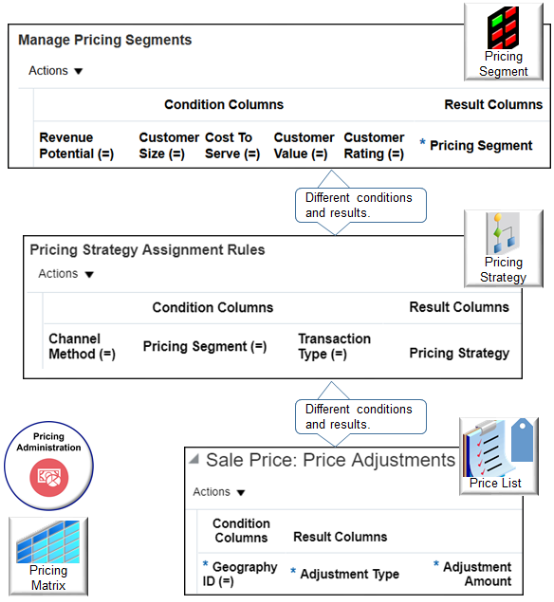Pricing Matrix
Use a pricing matrix to apply conditional logic on a pricing entity according to the value of an attribute that you specify.
A pricing matrix is an array that specifies conditions and results.
-
The array contains rows and columns.
-
Condition columns specify the condition to test, such as Customer Size equals Small.
-
Result columns specify what to do when the condition is true, such as use the Corporate Segment.
-
Each row specifies a separate condition and result.
Here's an example of a pricing matrix that assigns a pricing segment.

This matrix includes three rows. Each row specifies a rule that contains a condition and a result.
|
Row |
Condition |
Result |
|---|---|---|
|
1 |
If Revenue Potential is Very high, and:
|
Assign the Corporate Segment. |
|
2 |
If Revenue Potential is High, and:
|
Assign the International Segment. |
|
3 |
If Revenue Potential is Low, and:
|
Assign the Domestic Segment. |
At runtime, Pricing evaluates each row until it finds a match. If it doesn't find a match, then it sets a default value.
Here are the pricing entities where you can add a pricing matrix.
-
Pricing strategy assignment
-
Pricing segment
-
Price list
-
Cost list
-
Currency conversion list
-
Shipping charge list
The conditions and results are different for each type of pricing entity.

For example:
|
Pricing Entity |
Conditions |
Results |
|---|---|---|
|
Pricing segment |
Depending on the values of.
|
Set the.
|
|
Pricing strategy assignment |
Depending on the values of.
|
Set the.
|
|
Price list |
Depending on the value of.
|
Set the.
|
Add Conditions and Results in Pricing Matrixes
You can add up to 25 conditions and results in a pricing matrix when you create a pricing rule. You can use this capability to include more attributes from your customer, product hierarchy, or transaction when you set up your pricing rules. It also provides a wider variety of attributes that can you use to help analyze pricing in your reports.
- Use the Pricing Administration work area, file-based data import, or REST API to manage your matrix when you need to adjust attribute values on price lists or discounts lists.
- Use the Pricing Administration work area or REST API to assign the pricing strategies and manage the pricing segments that you use with these rules.
- Use the Pricing Administration work area to manage adjustment values for attributes on a price list or discount list, to manage pricing segments, assign pricing strategies, and create pricing guidelines.
- You can add up to only 10 conditions and results through Application Development Framework Desktop Integration (ADFDI). For details, see Use Spreadsheets to Manage Pricing.